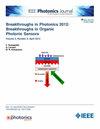Correlation Between Recombination Dynamics and Quantum Barrier Thickness in InGaN-Based Micro-LEDs
IF 2.1
4区 工程技术
Q3 ENGINEERING, ELECTRICAL & ELECTRONIC
引用次数: 0
Abstract
To tackle the efficiency droop, we employed an epitaxial structure engineering approach and utilized SimuLED software to thoroughly investigate the influence of the quantum barrier (QB) thickness on the performance of Micro-LEDs, and delve into the corresponding carrier transport behavior. The results demonstrate that the effect of QB thickness on the performance of Micro-LEDs is closely related to injection current density. Within the current density range of 0–30 A/cm 2 , a thicker QB layer leads to a higher internal quantum efficiency (IQE) for Micro-LEDs. Conversely, when the current density is in the range of 30–100 A/cm 2 , employing a thinner QB layer in the LED structure can yield higher IQE values. In addition, this work suggests that tunneling effects and Quantum Confined Stark Effect (QCSE) dominate at different current densities, resulting in an opposite dependency of IQE on QB thickness. Furthermore, our findings indicate that adjusting QB thickness can significantly affect both the peak external quantum efficiency (EQE) and peak current density of Micro-LEDs.基于ingan的微型led中复合动力学与量子势垒厚度的关系
为了解决效率下降问题,我们采用了外延结构工程方法,并利用 SimuLED 软件深入研究了量子势垒(QB)厚度对 Micro-LED 性能的影响,并深入研究了相应的载流子传输行为。结果表明,QB 厚度对 Micro-LED 性能的影响与注入电流密度密切相关。在 0-30 A/cm2 的电流密度范围内,QB 层越厚,Micro-LED 的内部量子效率 (IQE) 越高。相反,当电流密度在 30-100 A/cm2 范围内时,在 LED 结构中采用较薄的 QB 层可产生较高的 IQE 值。此外,这项研究还表明,在不同的电流密度下,隧道效应和量子约束斯塔克效应(QCSE)占主导地位,从而导致 IQE 与 QB 厚度的关系相反。此外,我们的研究结果表明,调整 QB 厚度可显著影响 Micro-LED 的峰值外部量子效率 (EQE) 和峰值电流密度。
本文章由计算机程序翻译,如有差异,请以英文原文为准。
求助全文
约1分钟内获得全文
求助全文
来源期刊

IEEE Photonics Journal
ENGINEERING, ELECTRICAL & ELECTRONIC-OPTICS
CiteScore
4.50
自引率
8.30%
发文量
489
审稿时长
1.4 months
期刊介绍:
Breakthroughs in the generation of light and in its control and utilization have given rise to the field of Photonics, a rapidly expanding area of science and technology with major technological and economic impact. Photonics integrates quantum electronics and optics to accelerate progress in the generation of novel photon sources and in their utilization in emerging applications at the micro and nano scales spanning from the far-infrared/THz to the x-ray region of the electromagnetic spectrum. IEEE Photonics Journal is an online-only journal dedicated to the rapid disclosure of top-quality peer-reviewed research at the forefront of all areas of photonics. Contributions addressing issues ranging from fundamental understanding to emerging technologies and applications are within the scope of the Journal. The Journal includes topics in: Photon sources from far infrared to X-rays, Photonics materials and engineered photonic structures, Integrated optics and optoelectronic, Ultrafast, attosecond, high field and short wavelength photonics, Biophotonics, including DNA photonics, Nanophotonics, Magnetophotonics, Fundamentals of light propagation and interaction; nonlinear effects, Optical data storage, Fiber optics and optical communications devices, systems, and technologies, Micro Opto Electro Mechanical Systems (MOEMS), Microwave photonics, Optical Sensors.
 求助内容:
求助内容: 应助结果提醒方式:
应助结果提醒方式:


